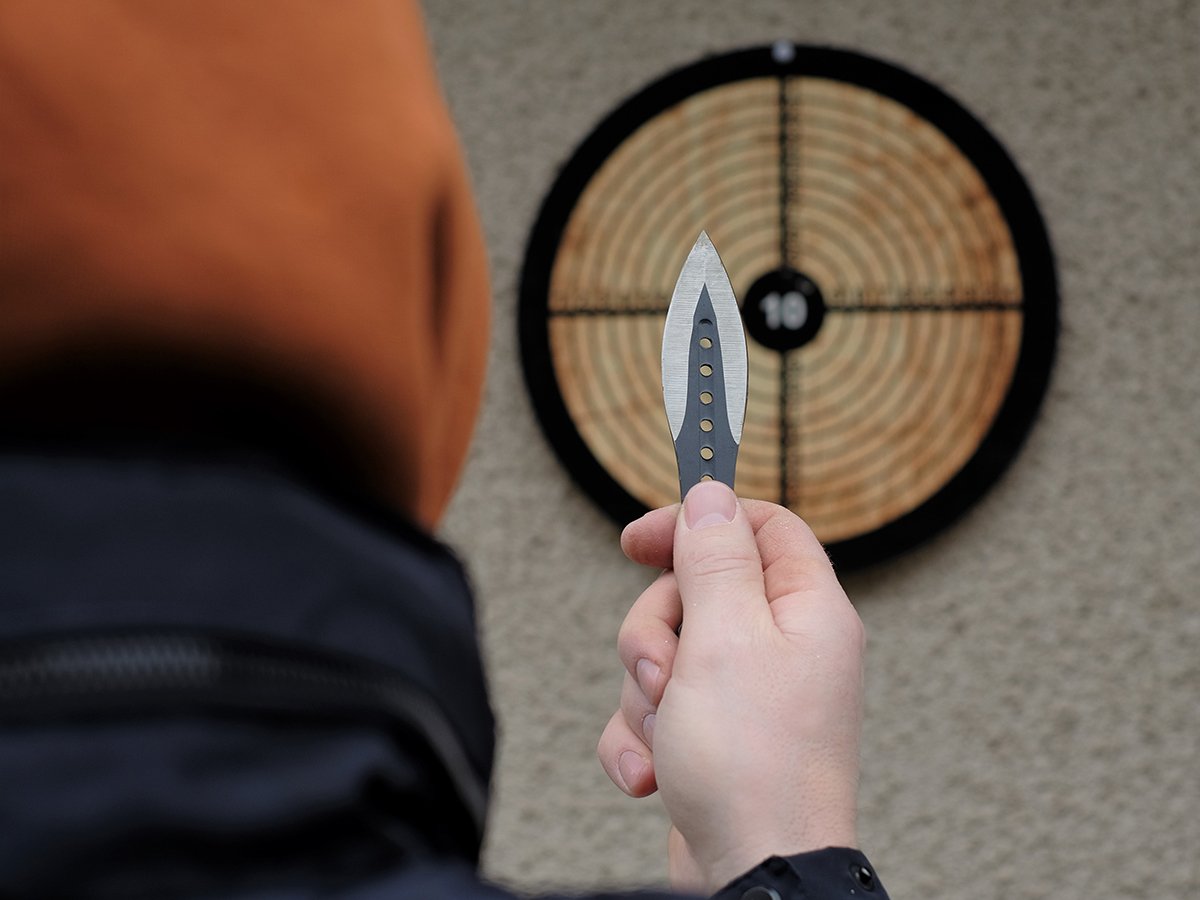How To Throw A Knife Correctly
There is no doubt that knife throwing is a fantastic hobby to have, and this article will teach you how to correctly throw a knife as a complete beginner step by step.
You can reach your goal of learning to throw a knife in a couple of weeks of practice. We are going to take a look at choosing an excellent, inexpensive throwing knife, and then we will explore the best ways to lob it correctly.
A complete beginner can quickly learn how to throw a knife correctly by following these steps:
- Choose a proper knife and target
- Find a safe place to practice
- Learn proper knife throwing by perfecting your grip and throw
- Continue practicing by varying throws with control, speed, number of turns, and distance
1. Find a knife you are comfortable with. Preferably you will want to purchase something inexpensive online. It doesn’t have to be anything fancy.
2. Find a safe place to practice. You will want to hang a target onto something that it will stick to.
The location can be in your backyard, in the woods, or preferably at a throwing facility in your community. It doesn’t matter where as long as you’re comfortable and can’t hurt anyone from bad throws.
3. Get your throwing form right and grip right. Place your feet about shoulder-width apart, and put your dominant foot forward (left foot if you’re left-handed) to give you more balance when throwing. Stand straight but in a relaxed body position.
To grip the knife, use your dominant hand to hold the knife like a hammer (if you’re right-handed, use your right hand and vice versa). If your using a balanced blade, place your fingers on the knife handle and your thumb on the opposite side of the handle, and make sure the blade is facing away from you (this is very important).
4. Practice tossing it by varying the distance from the target and varying the number of rotations that it makes heading toward the target. Those two things are the trick to learning proper techniques. Throw controlled and change the speed while practicing.
To start, you will want to be about 6 to 9 feet away from the target. Then practice at 18 feet from the target. Try to get at least one complete turn before hitting the target (9 feet from target) or two turn throw (18 feet from target). It helps to first practice throwing in your head and then by actually throwing it at the target.
I relate this action to the imaginary putt on the putting green. If you miss, toss it up again and keep trying. It won’t take you long to master.
You’ve just learned how to throw a knife correctly for a beginner, but we still want you to know more. Still skeptical about learning how to lob it? You can find the best, most reliable info in this article.
We will help you find the best, most reliable way to hurl it correctly, but you have to keep reading.
“When the World is at Peace, a gentleman keeps his knife by his side.” – Wu Tsu
Choose the best blade with the best center of gravity to learn how to throw a knife
Choice of knives may include a hunting knife or a survival knife but don’t use a breadknife. There are many kinds of knives, but there are only three main types of knives that are good for tossing: blade-heavy, handle-heavy, and balanced knives.
The well-balanced blade is usually the best for beginners and has the center of gravity at the center. They make circles in flight without wobbling. As you gain more experience, you can try a blade-heavy or handle-heavy blade.
No products found.
A throwing knife typically has no sharp edges, except for a very pointed tip. Some are double-edged, heavy-duty knives with a straight blade and a handle made of wood, plastic, or metal.
To keep from being bent, they are usually made thick but not too thick. They typically weigh 8 ounces or 200+ grams. The more heft that you can lob for an extended time, the better because a heavier one is much more stable in flight.
It’s best to avoid having too many perforations on the blade or handle as they tend to break easily. It’s also best to keep the blade handle as straight as possible. So, please don’t choose a throwing blade with a typical handle. Choose one with a flat handle making it smoothly glide out of your hand.
During training, keep in mind that it might be better to have a couple of knives in your arsenal. When you have a couple or more than a couple, you can toss one and then another without walking to the target after every lob flip.
While learning to throw a knife, don’t forget to get a good sheath for your knives. This will keep it safe and secure. You can either wear it on your belt with a good leg string or in a carrying pouch that you layout when you get to your throwing location.
Preparation before throwing
A professional blade tosser makes sure to wear a pair of heavy shoes, possibly steel-toed shoes so that if it bounces back, it won’t stab through to his foot.
During your process to learn how to throw a knife, choose a safe throwing target. You can buy throwing targets online that you can easily hang on to just about anything. Just make sure it won’t damage the blade when you toss it at the target.
No products found.
You’re looking for something sturdy but not too hard to hang a basic paper target on that the blade won’t easily penetrate. It usually means trees or lumber from the hardware store made of softwoods type.
Caring for your knives is very important. You will want to keep them clean and dry. Coating it with a protective oil like Ballistol or Militec-1 with a small soft dishtowel or rag will keep it well protected from rust.
The thrower can repair any nicks by putting them in a vise and filing any rough parts. To fix a bent blade, try putting it under a brick and standing on it to straighten.
“Always carry a knife with you. Just in case there’s cheesecake, or you need to stab someone in the throat.” – 4 Star General James Mattis
Knife Throwing Techniques
There are only three primary knife throwing techniques that you need to use:
No Spin Throw – For this throw you basically have to throw the tip toward the target. You’re not trying to make the blade spin and only want the tip to move in a straight direction. You usually use more force for this type of throw. You want the knife to get to the target quickly as possible to avoid it rotating while in air.
Slow Spin Throw – This throw also uses more force to move the knife toward the target. The idea is to throw as slow as possible with a certain number of turns before it sticks. Again, you’re trying to get the knife to the target as quickly as possible to avoid rotation.
Fast Spin Throw – With a fast spin, you want the knife to turn as many times as possible but know with intuition how many turns you’re making. You do not need to use as much force with a fast spin throw.
Rotational knife throwing techniques, good form, and the best way to grip the knife to properly learn how to throw a knife
To throw a knife, the best grip for a beginner begins with a balanced knife. You want to hold it like you would hold a hammer. Keep your wrist completely stiff when you heave it. Only grip by the handle and not the blade when you’re first starting out.
Note: If you’re not using a balanced blade and if the balance is off from being wholly balanced from head to toe, then grip the lightest end of it. So, for instance, if you’re throwing a blade-heavy knife, you will hold and pitch from the handle.
Change your grip if you’re using a handle-heavy throwing knife to avoid cutting yourself. You might consider a pinch grip for those types of knives.
Use a clean throwing movement. Use a proper arm-shoulder movement keeping the entire movement fluid and not with your wrist, letting it slide completely out of your hand. Don’t toss with a powerful toss. Use a moderate toss just enough to get it to stick into your target.
A list of our favorite Adult Outdoor Activities
Practice tossing it first in your mind. Most folks know how to putt. When you putt, you do a little practice putt most of the time before actually hitting the ball. Practice tossing it in your mind then practice tossing it for real.
When you lob it, make sure to watch it throughout its trajectory toward the target. You will want to toss it at the target and have it complete one complete turn before striking a target at 9 feet away. Practice varying the distance and getting it to stick into the target using only one blade turn.
Throw a knife using various techniques
Throwing knives may be used in competitions for recreational purposes, or as a weapon for self-defense. The basics of throwing are relatively simple. As long as you have a blade and a target, you can practice throwing it. The more you practice, the better you’ll become at making deliberate lobs at your target.
To throw a knife correctly, practice is the key to becoming a perfect thrower. I once watched a video where a guy shot a hundred arrows at a target every day. That was his goal. He became better quickly.
Have a weekly or daily practice session. Get lots of practice to become better. Muscle memory improves over time with you tossing more and more tosses. Keep tossing it at a target, and you will get better. You might even be able to hit 10 out of 10 while your friends watch in amazement.
No products found.
In conclusion:
Put a little time and effort into mastering the art of throwing knives, and you can enjoy an activity that may seem dangerous, but in reality, is quite safe. It is a great hobby to have after you’ve mastered the form of tossing. Then learn advanced throwing techniques.
You will quickly discover that throwing a knife can be a lot of fun. You might consider using this as an additional self-defense weapon in your arsenal.
You will find blade pitching quite entertaining and enjoyable to master. It has become one of my favorite hobbies. I recommend picking up several different types of throwing knives that will fit your budget and start tossing them at your target.
The only caution you need to take is that you should always be careful. Always follow directions and use common sense while learning to throw a knife.
Never lob it at moving objects, or people could cause serious injury. The best thing to do is to practice in a safe environment.

Meet Kevin Goodell, your outdoor adventure coach! With a passion for nature ignited in childhood, Kevin brings a wealth of experience and expertise to simplify tough outdoor skills. As a U.S. Army veteran and former Sergeant, he has honed his leadership and teamwork abilities while developing a deep love for the great outdoors.
Kevin’s dedication to outdoor activities spans biking, birdwatching, national park trips, and archery/golf. With his friendly and approachable demeanor, he is committed to guiding individuals of all ages and skill levels towards unforgettable outdoor experiences.
Harnessing his extensive knowledge and personal achievements, Kevin is your go-to resource for learning and enjoying various outdoor pursuits. Whether you seek thrilling adventures or serene nature escapes, Kevin’s professional yet friendly approach will ensure an engaging and informative experience. Embark on your next outdoor adventure with Kevin Goodell and embrace the beauty of nature like never before.






